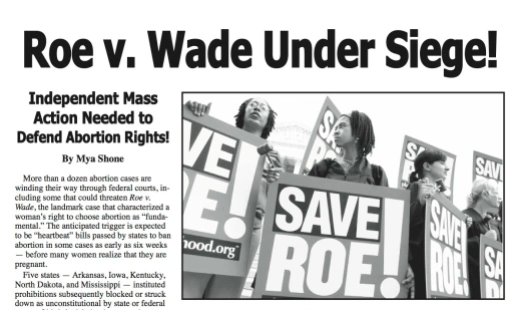Independent Mass Action Needed to Defend Abortion Rights!


Originally published on 10/5/2019
By Mya Shone, member, Editorial Board, The Organizer
More than a dozen abortion cases are winding their way through federal courts, including some that could threaten Roe v. Wade, the landmark case that characterized a woman’s right to choose abortion as “fundamental.” The anticipated trigger is expected to be “heartbeat” bills passed by states to ban abortion in some cases as early as six weeks — before many women realize that they are pregnant.
Five states — Arkansas, Iowa, Kentucky, North Dakota, and Mississippi — instituted prohibitions subsequently blocked or struck down as unconstitutional by state or federal courts. Ohio’s legislation has yet to be tested, while Georgia Governor Brian Kemp is poised to sign a state ban. Five more states — Florida, Missouri, Ohio, Tennessee and Texas — are among those expected to approve “heartbeat” measures this year.
“This is terrifying,” declared Planned Parenthood President Leana Wen. “It is a horrific trend when it comes to escalating attacks on women’s health care.”
We need only grasp the basis of the 1973 Roe v. Wade decision to understand how this came about. The majority opinion, written by Justice Harry A. Blackmun, was rooted in a woman’s right to privacy, which he found implicit in the liberty guarantee of the due process clause of the Fourteenth Amendment. The Court still asserted a “compelling state interest” in the health of pregnant women and in the potential life of fetuses. It placed the point at which states could intervene on issues of a woman’s health at “approximately the end of the first trimester” of pregnancy while “capability of meaningful life outside the mother’s womb,” assumed to occur only during the last trimester, bolstered by a vague concept of viability, were specified with regard to the fetus.
In 1992, the Supreme Court narrowed the scope of Roe v. Wade. By 2016, states had enacted 1,142 abortion restrictions.
In 2015, Kansas became the first state to pass a total ban on the procedure used most often for second trimester abortions: dilation and evacuation. At least 11 states followed suit, although most laws remain on hold as they wend their way through the legal system. One case reached the U.S. Supreme Court. This month the Court will decide whether to consider Alabama’s appeal of the 11th U.S. Circuit Court of Appeals ruling that struck down the state’s attempt, as in Kansas, to ban the most common approach to second trimester procedures.
New threats against women’s reproductive rights are multiplying with 304 proposals to restrict abortion in some form introduced in states across the country in just the first three months of this year. Alabama lawmakers introduced legislation that would make performing an abortion at any stage of pregnancy a felony unless the mother’s health were in jeopardy. A probate judge, basing his decision on Alabama’s “personhood” law, recognized the legal rights of an aborted fetus, allowing a man whose girlfriend ended her pregnancy to sue both the manufacturer of the pill that she used as well as the clinic that provided it.
Overwhelming the courts with test cases is precisely what opponents of a woman’s right to choose are galvanizing. They await the day when the Court, which includes two new Trump appointees, Neil Gorsuch and Brett Kavanaugh, takes on a case that strikes at the heart of Roe v. Wade.
That moment is close at hand. Aside from challenges to the “fetal heartbeat” laws, objections to TRAP (targeted restrictions on abortion providers) laws now flood the courts. This January, abortion providers in Louisiana asked the Supreme Court for an emergency stay of a 2014 state law that would have left only one doctor eligible to perform the procedure for 10,000 women seeking abortions each year in Louisiana. The law requires any physician providing abortion services to have admitting privileges at a hospital within 30 miles of the procedure. This law had been blocked by a Circuit Court judge but a panel on the U.S. Court of Appeals for the 5th Circuit voted to allow the state law to go into effect and the full court decided not to reconsider this decision.
The Louisiana law is nearly identical to one of the provisions of a Texas law that the Supreme Court struck down in Whole Women’s Health v. Hellerstedt, 579 U.S. in 2016. The Court ruled that the Texas law, which required additionally that abortion clinics meet the building requirements for ambulatory surgical centers, “provides few, if any health benefits for women, poses a substantial obstacle for women seeking abortions, and constitutes an ‘undue burden’ on their constitutional right to do so.”
The Supreme Court today, however, has a significantly different composition. While Chief Justice John Roberts sided with the Court’s four liberal justices to grant a temporary pause in the Louisiana litigation, he was also a signatory to a dissenting opinion in the Whole Women’s Health Texas decision. But if the Court declines to hear this Louisiana case, the 5th Circuit Appellate Court decision will be left standing. This will have drastic consequences for women across the United States as more than two dozen states have enacted similar laws and regulations.
Access to safe abortion is not a theoretical issue. Nearly one in four U.S. women will have an abortion in their lifetime, with the greatest concentration among poor women, who accounted for 49% of patients in 2014.
In 2014, 90% of U.S. counties had no clinics providing abortions. More than one in three women (39%) of reproductive age lived in these counties and would have to travel – many for great distances – to obtain an abortion. Six states, including North Dakota and Mississippi, are now down to one abortion clinic.
Emma Goldman, the renowned anarchist and feminist, insisted always that birth control had to be viewed in the context of capitalism. Women would suffer a double yoke of oppression from ruling class social, economic and political forces until they win control over their reproductive choices. By 1915, Margaret Sanger, whom Goldman had mentored, joined her in building a mass movement for birth control. On the eve of Goldman’s April 5, 1915 trial for violating the 1873 Comstock Law, which prohibited the distribution of birth control literature, she gave a fiery speech on “The Social Aspects of Birth Control.” Goldman concluded by declaring, “I may be arrested, I may be tried and thrown into jail, but I never will be silent. …”
Seventy-seven years later, on April 5, 1992, 700,000 people streamed into Washington, D.C. to march and rally in support of abortion rights. It was one of the largest protests in the nation’s capital up to that time. They mobilized to send a forceful message to the U.S. Supreme Court, which was set to consider the constitutionality of a Pennsylvania state law placing substantial restrictions on access to abortion. Many feared that Roe v. Wade itself was under threat and their concerns were well founded. While the Court did not throw out Roe, it undermined it by replacing the “fundamental” Roe standard with a far less protective “undue burden” criterion of review for evaluating state restrictions on abortion.
The struggle continues now more than ever with increasing urgency. There is no substitute for women and men mobilizing to demand their rights. These independent mass actions, along with our efforts to build a labor- and community-based independent party, show our determination that reproductive rights are inherent to our well-being and emancipation.

